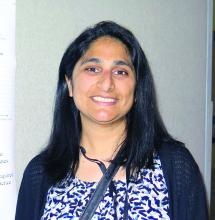TORONTO – Teaching simple quality improvement principles to individual pediatric practices can improve adolescent human papillomavirus (HPV) vaccination rates, results from a multicenter study showed.
“We know that HPV vaccination rates are low, and there have been many efforts to improve the vaccination rates nationwide,” one of the study authors, Manika Suryadevara, MD, said in an interview at the Pediatric Academic Societies meeting. “One reason that vaccine rates are low in adolescents is missed opportunities. Adolescents don’t always show up for routine well-child visits where immunization records are reviewed, but they may show up with a cold, a sprained ankle, or a hospital follow-up. Providers do not routinely check immunizations at these visits, then don’t recommend vaccine to those who need it. These are the missed opportunities we need to act upon.”
Dr. Suryadevara, of the State University of New York Upstate Medical University in Syracuse, and her associates recruited five large pediatric practices from the New York American Academy of Pediatrics Chapter 1 to participate in a quality improvement (QI) project aimed at reducing missed vaccination opportunities in an effort to improve vaccine completion rates. The project began by having one clinical provider and one staff member from each practice attend an educational training session about QI principles and tools such as a value stream map, an impact matrix, and plan-do-study-act cycles. The training session also covered HPV epidemiology and associated cancers, vaccination rates, and recommended systematic changes to improve practice vaccination rates. Following the training session, representatives from each practice performed a monthly chart review of 10-20 consecutive patients aged 11-12 years seen in the office and collected data regarding patient gender and age, type of visit (well-child, acute, follow-up, nurse-only), if HPV vaccine was due or not, provider vaccine recommendation documentation, and vaccines administered, “so they can see where their missed opportunities were,” she said.Data were entered into the AAP Quality Improvement Data Aggregator and run charts were printed. Next, each practice held monthly team meetings for 5 months to discuss chart review data, run chart results, and to determine intervention change for the next cycle. “Most of the interventions included standing orders, optimizing nurse’s visits, using electronic medical reminders to review immunization records, and having immunization records pulled for all adolescents who show up in their practice,” Dr. Suryadevara said. “The goal of these systematic changes is to make the work flow seamless.”
Analysis of run chart data revealed that over the five monthly cycles, the HPV vaccine completion rate improved from 45% to 65%, while the overall HPV vaccine missed opportunities was reduced from 45% to 19%. Specifically, reductions in missed opportunities fell from 9% to 0% during well-child visits, from 80% to 61% during acute visits, from 25% to 0% during follow-up visits, and from 11% to 0% during nurse-only visits. “We did see missed opportunities for acute visits – those who come in sick, but even these missed opportunities decreased over the 6-month study period,” Dr. Suryadevara said.
During follow-up teleconference calls, practice representatives reported positive experiences about the QI process and outcome improvements. “Once the practices were able to pull everyone on board and develop practice changes, I wasn’t surprised that the interventions worked,” she said. “They were able to develop systematic interventions, change the work flow in their practice, and get the results we anticipated.”
The study was funded by the AAP Hub and Spoke Initiative. Dr. Suryadevara reported having no financial disclosures.


